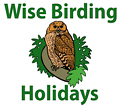
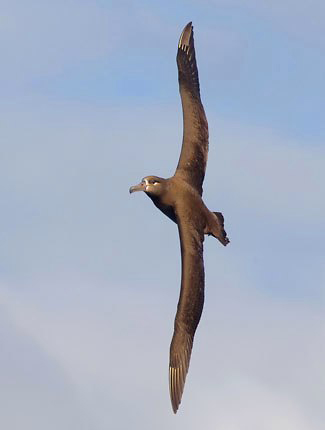
Black-footed Albatross by Graham Ekins.
- The best chance of Bobcat in the world
- A good chance of Blue and Humpback Whales, and Pacific White-sided Dolphin
- As well as other mammals such as Northern Elephant Seal, Sea Otter, sealions, fur seals and Black Bear
- Several speciality birds including the state endemic Yellow-billed Magpie, and the near-endemic Allen's Hummingbird, Nuttall's Woodpecker, Wrentit, California Thrasher, California Towhee and Tricoloured Blackbird
- And some of North America's and the world's most spectacular birds including Black-footed Albatross, the reintroduced California Condor, Roadrunner, Mountain Bluebird and Clark's Nutcracker
- As well as the tallest trees in the world (Coast Redwoods), the largest trees in the world (Giant Sequoias) and the oldest trees in North America (Bristlecone Pines)
- All in some scenic settings, not least Yosemite Valley, one of the most beautiful sights on Earth
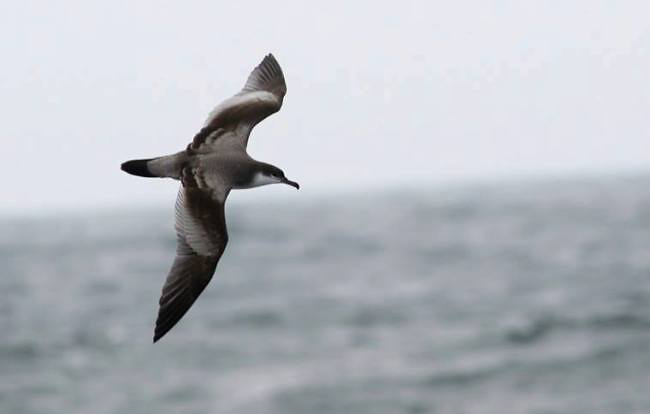
Buller's Shearwater and Black Turnstone by Chris Townend.
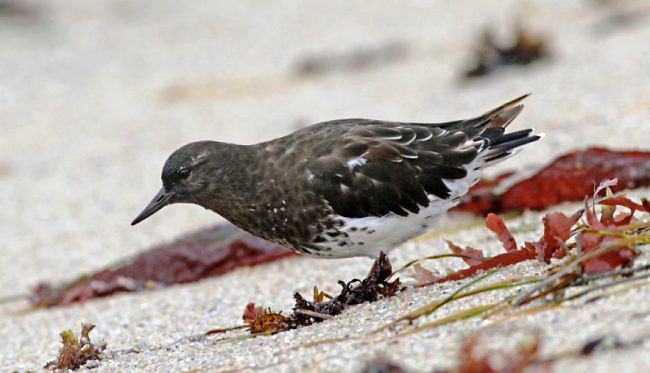
- The Blue Whale is not only the largest animal in the world it is also the largest thing that has ever lived, bigger even than the biggest dinosaurs. The average length is about 26 metres (86 feet) but some individuals may exceed 30 metres (100 ft) and the longest recorded was an incredible 33.6 metres (110 feet, 2 inches). They occur around virtually the whole planet but one of the most reliable places to see them is Monterey Bay where the rich upwellings from an underwater canyon close to shore help provide food for a great variety of seabirds as well as, occasionally, the big blues.
- Most of California's bird specialities can be seen in the north but Lawrence's Goldfinch is difficult to see there, and Island Scrub-jay (Santa Cruz Island) and California Gnatcatcher (which also occurs throughout Baja California in Mexico) are restricted to the south. California is a big state and even just the northern half is difficult to cover well in two weeks, but if time is available to cover the southern half as well then it may be worth considering a trip across the border into Arizona to see the nearby Grand Canyon and maybe some or all of the others in Our Top 50 Other Natural Wonders which are situated in Arizona and Utah, such as The Wave, Monument Valley and Meteor Crater.
Best Birds and other wildlife in Northern California
Birds
California Condor (reintroduced), (Greater) Roadrunner, Black-footed
Albatross, Mountain Bluebird, Clark's Nutcracker, American Avocet, specialities such as the endemic
Yellow-billed Magpie and the near-endemic Allen's Hummingbird, Nuttall's Woodpecker, Wrentit, California
Thrasher, California Towhee and Tricoloured Blackbird, as well as Wild Turkey, Blue (Sooty) and (Greater)
Sage Grouse, Mountain and California Quails, Western Grebe, Buller's, Pink-footed and Sooty Shearwaters,
Black and Ashy Storm-petrels, Brown Pelican, Golden Eagle, Prairie Falcon, American Black Oystercatcher,
Black-necked Stilt, Black Turnstone, Wilson's, Grey and Red-necked Phalaropes, Heermann's and Sabine's
Gulls, South Polar, Pomarine, Arctic and Long-tailed Skuas, Pigeon Guillemot, Marbled Murrelet, Cassin's
and Rhinoceros Auklets, Great Horned and Burrowing Owls, Anna's Hummingbird, Belted Kingfisher,
Red-breasted and Williamson's Sapsuckers, Lewis's, Acorn, White-headed and Pileated Woodpeckers, Northern
Flicker, Steller's, Western Scrub and Pinyon Jays, Chestnut-backed Chickadee, Bushtit, Pygmy, Red-breasted
and White-breasted Nuthatches, American Dipper, Western Bluebird, Black-throated Grey, Townsend's, Hermit
and MacGillivray's Warblers, Western Tanager, sparrows, Western Meadowlark and Yellow-headed Blackbird.
Also a chance of Bald Eagle and Lawrence's Goldfinch, as well as American White Pelican, Black Skimmer,
Great Grey Owl and Pine Grosbeak.
Mammals
Bobcat, Humpback (mostly May-Nov) and Grey (mostly Dec-Apr) Whales,
Northern Elephant Seal (mostly mid-Dec to mid-Mar), Sea Otter, (Long-beaked) Common, Pacific White-sided and
Risso's Dolphins, Dall's and Harbour Porpoises, California and Steller's Sealions, Northern Fur Seal, (Tule)
Elk, Grey Fox, Coyote, chipmunks and kangaroo rats. Also a chance of Blue (mostly Aug-Sep), Fin (mostly May-Nov) and Killer (mostly
second half of April) Whales, Common and Northern Rightwhale Dolphins, Black Bear, North American River
Otter and even Long-tailed Weasel.
Reptiles, Amphibians and Fish
A chance of Basking and Blue Sharks, Blue
Marlin and Ocean Sunfish (Mola mola).
Invertebrates
One winter roost of Monarch butterflies, at Natural Bridges State Beach in Santa Cruz on the north shore of
Monterey Bay, contained 8000 individuals in 2016 (way down from as many as 100,000 in the past). They are usually present from mid-October to mid-February
but leave in January some winters. November is the best time to visit.
Plants
Coast Redwood (Sequoia sempervirens), the tallest tree species
in the world, reaching a record height of 115.5 m (379 ft); Giant Sequoia (Sequoiadendron giganteum),
the largest tree species in the world; and Bristlecone Pine (Pinus longaeva), the oldest tree
species in North America, many over 4500 years old.
Other Natural Wonders of Northern California
Muir Woods NM The tallest trees in the world, Coast Redwoods, grow here.
Yosemite Valley This is one of the most beautiful places in the world. The scenery is stunning, thanks to the massive rock formations adorned by waterfalls (which usually reach peak flow in May-June, and which may be dry by August). Along the 13 km (8 mile) long valley sheer granite walls rise up from the flat valley floor for 910 m (3000 ft) at El Capitan, with the 188 m (617 ft) Bridalveil Fall opposite, and at the head of the valley Half Dome, with a sheer rock wall of 670 m (2200 ft), rises 1444 m (4738 ft) above the valley floor. In keeping with the scale of the landscape the largest trees in the world, Giant Sequoias, grow in nearby Mariposa Grove.
Mono Lake Where freshwater enters this lake calcium carbonate deposits, precipitated by algae, form what are commonly known as 'tufa towers'.
White Mountains The oldest trees in North America, Bristlecone Pines, grow here, at places such as Schulman Grove/Ancient Bristlecone Pine Forest where some of the oldest trees are believed to be over 4700 years old.
Sequoia NP The largest trees in the world, Giant Sequoias, grow here, including the biggest of them all by volume; known as General Sherman, it has a 31 m (101 ft) circumference at its base and is 84 m (275 ft) high.
Best Sites for Birds and other wildlife in Northern California
- North of San Francisco
- Cordell Bank and Bodega Canyon Pelagic boat trips out of the small town of Bodega Bay, especially during the second half of September, for Humpback Whale, Pacific White-sided and Risso's Dolphins, and sometimes thousands of seabirds, including Black-footed Albatross, Pink-footed and Buller's Shearwaters, Black and Ashy Storm-petrels, Grey and Red-necked Phalaropes, Sabine's Gull, South Polar, Pomarine, Arctic and Long-tailed Skuas, Pigeon Guillemot, and Cassin's and Rhinoceros Auklets. Also a chance of Blue and Killer Whales, Northern Rightwhale Dolphin, Basking and Blue Sharks, Blue Marlin, Ocean Sunfish and other seabirds such as Flesh-footed Shearwater and Fork-tailed Storm-petrel.
- Point Reyes NS Bobcat (especially along Pierce Point Road), Northern Elephant Seal (near lighthouse), (Tule) Elk, Grey Fox, Coyote, shorebirds including Wandering Tattler, Black Turnstone and Surfbird, Heermann's Gull, Anna's Hummingbird, Wrentit and passage migrants including Rufous Hummingbird, Black-throated Grey Warbler and Western Tanager during spring. Also a chance of North American River Otter (Abbott's Lagoon) and even Long-tailed Weasel.
- Muir Woods NM Coast Redwoods.
- South of San Francisco
- Ano Nuevo SNR Northern Elephant Seal and Steller's Sealion. Also a chance of Marbled Murrelet. (There is another, larger, Northern Elephant Seal colony south of Monterey at Piedras Blancas).
- Natural Bridges State Beach, Santa Cruz Up to 100,000 wintering Monarch butterflies (mostly Nov-Feb).
- Monterey Bay NMS Humpback Whale, Sea Otter (especially at Moss Landing), California Sealion, Black-footed
Albatross, Buller's, Pink-footed and Sooty Shearwaters, Black and Ashy Storm-petrels, Black Turnstone, Grey
and Red-necked Phalaropes, Sabine's Gull, South Polar, Pomarine, Arctic and Long-tailed Skuas, Pigeon
Guillemot, Marbled Murrelet and Rhinoceros Auklet. Also a chance of Blue and Killer Whales, Northern
Elephant Seal, Pacific White-sided, Risso's and Northern Rightwhale Dolphins, Dall's and Harbour
Porpoises, Northern Fur Seal and other
seabirds such as Flesh-footed Shearwater. - Andrew Molera SP Area A chance of California Condor.
- Pinnacles NM Bobcat (especially area just to the east, mostly Nov-Mar), (Greater) Roadrunner, Yellow-billed Magpie, California Thrasher and Western Tanager. Also a chance of California Condor, Phainopepla and Lawrence's Goldfinch.
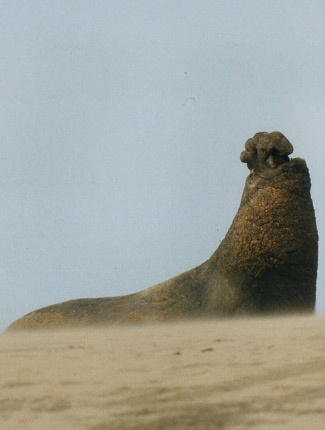
Northern Elephant Seal at Ano Nuevo State Nature Reserve by Nigel Wheatley.
- Sierra Nevada
- Sequoia NP Giant Sequoias including the largest tree of all by volume; known as General Sherman, it has a 31 m (101 ft) circumference at its base and is 84 m (275 ft) high.
- White Mountains Clark's Nutcracker and Pinyon Jay in Bristlecone Pines.
- Yosemite NP Giant Sequoias, Clark's Nutcracker, Golden Eagle, woodpeckers including White-headed, Steller's Jay, Red-breasted Nuthatch, American Dipper, Western Bluebird, and Black-throated Grey and MacGillivray's Warblers. Also a chance of Black Bear, Great Grey Owl (for example, around the edges of Chevron and McGurk Meadows in the west), Mountain Quail and Blue (Sooty) Grouse.
- Mono Lake Mountain Bluebird, Black-necked Grebe (over 1.5 million are believed to pass through here, mostly in August), Wilson's and Red-necked Phalaropes (up to 150,000 of these two species have been recorded in August), California Gull breeding colony, Pinyon Jay, Yellow-headed Blackbird and 'tufa towers' (calcium carbonate deposits). Also a chance of (Greater) Sage Grouse and Lewis's Woodpecker.
- Bridgeport Reservoir A chance of Bald Eagle and American White Pelican.
Best Times for Birds and other wildlife in Northern California
The best time to look for birds is mid-August to mid-September when summer visitors are still present, migrating birds from the north are passing through and there is usually the greatest variety of seabirds. This coincides with the best time for Blue and Humpback Whales, but not the peak time for Northern Elephant Seals (the males of which are most likely to be seen between mid-December and mid-March), Killer Whales (which are most likely during the second half of April) or wild flowers (which are usually at their best at lower elevations during the first half of May and at higher elevations in Yosemite NP during late July-early August).
Recommended Bird Books etc. for Northern California
Mammals of North America by R W Kays and D E Wilson. PUP, 2009 (Second Edition).
Mammals of North America by F A Reid. Peterson North American Field Guides, 2006 (Fourth Edition).
Peterson Field Guide to Finding Mammals in North America by V Dinets. Houghton Mifflin, 2015.
Field Guide to the Birds of North America edited by J Dunn and J Alderfer. NGS, 2017 (Seventh Edition).
Kaufman Field Guide to Birds of North America by K Kaufman. Houghton Mifflin, 2005.
The North American Bird Guide by D Sibley. Helm, 2014 (Second Edition).
Birding Northern California by D Taylor and J Kemper. Falcon Press, 1999.
Kaufman Field Guide to Butterflies of North America by J Brock and K Kaufman. Houghton Mifflin, 2003.
Apps etc.
National Geographic Birds: Field Guide to North America.
The Sibley eGuide to the Birds of North America.
Peterson Birds of North America.
Audubon Birds - A Field Guide to North American Birds.
iBird Ultimate Guide to Birds.
Birding and Wildlife Trip Reports for Northern California
Many trip reports, some for Northern California, are posted on the websites listed here. On some of these websites some reports are independent and some are posted by tour companies who organize tours to Northern California. These tour companies and others also post their own reports on their websites, which are listed under 'Some Organized Tours to Northern California' below.
- The best website for trip reports is CloudBirders
- but these are also worth a look
- Birdtours
- Fatbirder
- Jon Hornbuckle
- Mammal Watching
Local bird and wildlife guides in Northern California
The costs of organized tours partly reflect the quality of the tour leaders. Some leaders are certainly better than others and many companies claim their leaders are the best but even the best rely at least to some extent on the exceptional skills of the local guides they employ. If you are travelling independently, employing such local guides will greatly increase your chances of seeing the wildlife you wish to see.
- Shearwater Journeys (boat trips)
- Y Explore (Yosemite NP)
Accommodation for birders in Northern California
Some Organized Tours for birds and other wildlife to Northern California
There are many tour companies who organize tours to see mammals, birds, other wildlife and other natural wonders. The cost of these tours vary considerably according to such variables as the airlines used, the number of days the tours last, the number of sites visited, the number of people in the group (an important consideration if you wish to see such wildlife as rainforest mammals and birds), the number of tour leaders, the standard of accommodation and transport, and the percentage profit the company hopes to make. Generally, where the number of days tours last and the number of sites visited are similar, the cheapest tours are those that use the cheapest airlines, accommodation and local transport, that have the largest groups with the least number of leaders, and that make the least amount of profit. The most expensive tours tend to be those which are exceptionally long, use the most expensive accommodation (ridiculously lavish in some cases, even for single nights) and which make the most profit. Some tour costs partly reflect the quality of the tour leaders. Some leaders are certainly better than others and many companies claim their leaders are the best but even the best rely at least to some extent on the exceptional skills of the local guides they employ.
While tour companies organize tours with set itineraries many also organize custom tours for individuals and private groups who instead of taking a tour with a set itinerary want to follow their own itinerary to suit their own personal tastes, whether it be mammals, birds, other wildlife, other natural wonders or even man-made attractions, or a mixture of them all. Many organized tours with set itineraries are also fast-paced and target as many species as possible, whether they are mammals, birds or other wildlife or everything, which usually leaves little time to enjoy the best sites and individual species, but on a custom tour those taking part can specify the pace and the sites and species they wish to concentrate on. Custom tours also suit people who like to travel with people they already know, rather than with a group of strangers, and people with partners with different interests. Individuals and small groups will almost certainly have to pay more than the price of an organized tour with a set itinerary but a large group of friends may be able to travel for less than the price quoted for a set tour.
Tour companies who run organized tours or can arrange custom tours to Northern California include the following.
- Birdfinders
- Eagle-Eye Tours
- Field Guides
- Victor Emanuel Nature Tours
- Wise Birding Holidays
- We are a small wildlife watching holiday company based in Devon (UK) specialising in birdwatching and mammal watching holidays across the world. What sets us apart from other wildlife watching companies is quite simple:
- 1 – small group sizes: (average between 4 – 8 people)
- 2 – a commitment to conservation: (donation after each tour)

